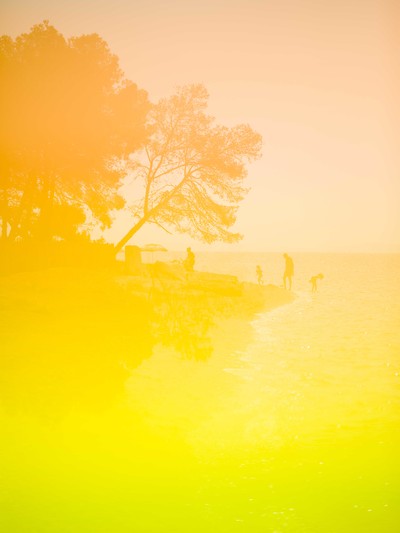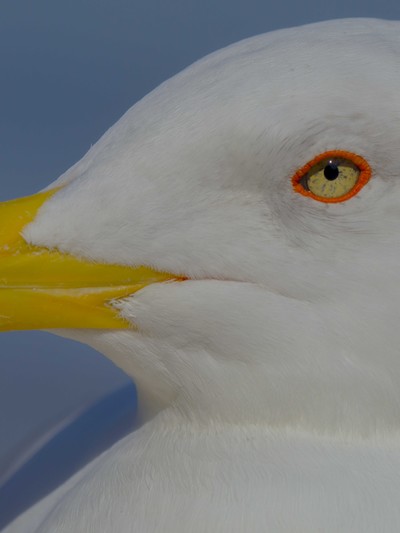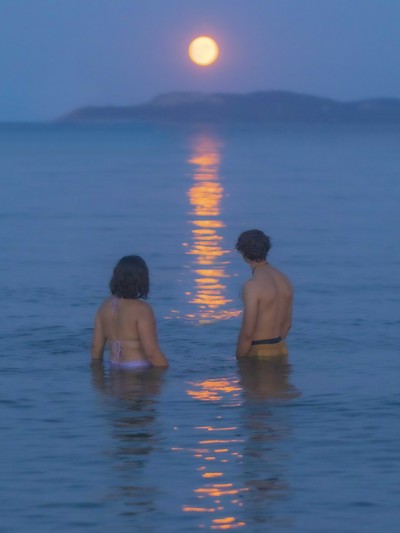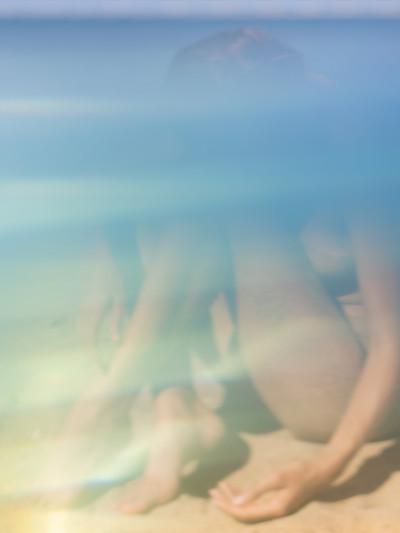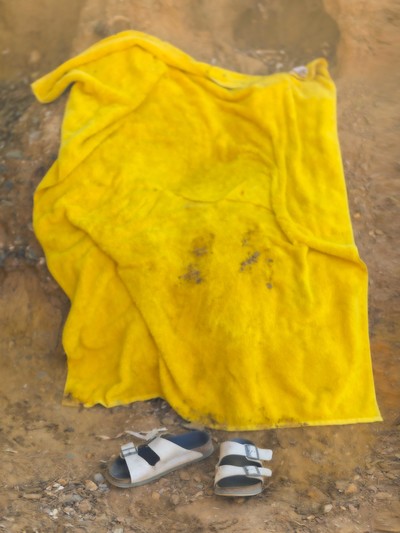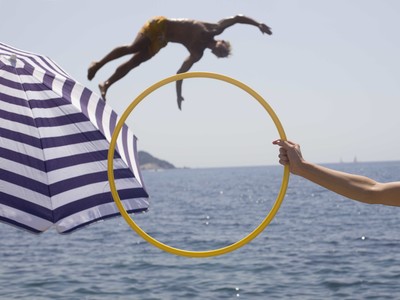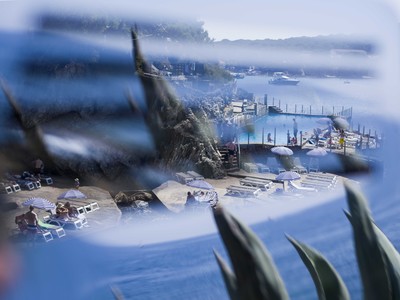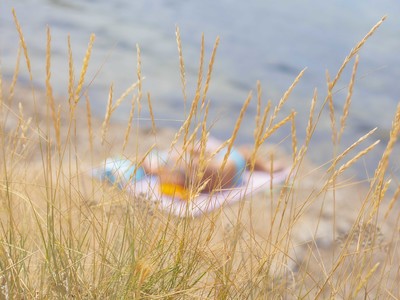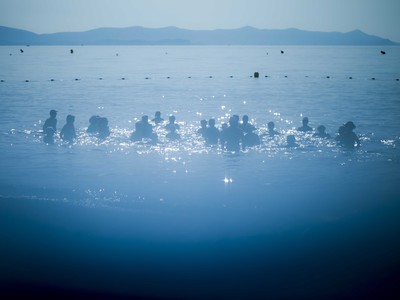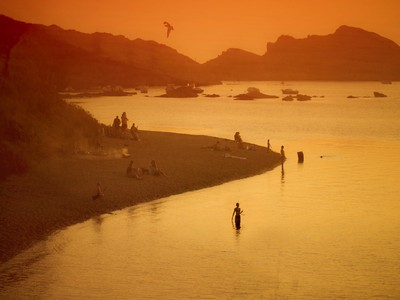“Paul, la plage et les peintres” de Paul Rousteau
from 24 November 2023 to 10 March 2024« Paul, la Plage & les Peintres »
from November 24, 2023 to Mars 10, 2024
The Villa Noailles presents here the
artistic commission given to the French
photographer and artist Paul Rousteau,
carried out in residence every summer for
the past five years in Hyères, with eight
French contemporary painters invited to
spend a creative time on the theme of the
beach:
Florent Groc, Diane Dal Pra, Marion
Bataillard, Thomas Levy Lasne, Jules
Magistry, Jean Claracq, James Della Negra
& Marcos Carrasquer.
Jean-Pierre Blanc invited me to take up a photography residency in July 2018. July, the beginning of the holidays. Families are finally arriving on the beaches of Hyères, after a year waiting for the summer holidays, dreaming of them. Jean-Pierre and I observe the joy of the families as they go for their first dip in the sea. “It would be beautiful to illustrate this happiness on the beach,” he said, dreaming aloud. I was enthusiastic. Especially as the Hyères coastline, Jean-Pierre told me, is 42 kilometres long. A marathon. A wonderful playground for me, who loves summer, holidays, sun… and the villa so much. I immediately thought of this photo book I used to go through as a child: Robert Doisneau’s Les Grandes Vacances (Summer Holidays). It was the only book of photographs in my parents’ library. I loved it. It is a vision of happiness in black and white, in the France of the 1930s-1960s. Families enjoying their paid holidays, often in swimming suits.
I want to create my own version, half a century later, in colour, in Hyères les Palmiers. But to make it happy, I don’t want to be alone facing the beach. Otherwise, the book would be called “Seaside Loneliness”. As I love painting above all and don’t personally know this generation of young artists, I have decided to share my residency with two new painters every summer. The rule of the game: spending a week together on the beach and having them produce a painting to be exhibited on the theme of the beach, to foster a dialogue between the arts and blend our points of view.
Paul Rousteau
The taste of salt, the waves’ percussion, the sand’s caress, the scent of seaweed and the immensity to be admired: the beach is a total sensory experience. Of all your five senses, your sight is certainly the most challenged by the beach: it needs to grasp all at once three infinities lying one upon the other: the infinity of the shore, the sea, and the sky. No matter how long you stand on the shore, your eye is disconcerted, stunned. It simultaneously senses the wonder of the landscape and the impossibility of capturing it fully. For the beach is elusive, it slips away. And your eye, in love, is defeated.
This particular situation transforms your bodies, attitudes and gestures. The amazed vanquished yearns, lays down their towel and gets lost in contemplation. The eye will never possess the beach, it admits defeat yet never gives up on seeing. Whenever it returns to the coast, season after season, it pursues an eternal quest. Some people come to the beach to bathe their eyes. They don’t enter the water but enjoy the shore in a completely different way: they stand out with their slow movements and supple necks.
What are we really looking at on the beach?
The landscape? Certainly, but very soon –we’ve all experienced it– the sand, the waves, and the blue blend into each other under the action of the sun. An invisible brush blends the show into a wash, and our vision blurs. The visual experience gets deep. You dive into a daydream. Slowly, images appear on the sky, in the sea, images from far away, from the past or elsewhere, projected onto the shore. For the beach is a cinema. A projection room where you contemplate, half-unconsciously, your inner sensations coming to life as if by magic on the coast, now turned into a screen.
You also look at your fellow human beings on the beach: it takes on the appearance of a human theatre. Bodies are revealed like nowhere else: desirable, striking. The sand becomes a stage, and the spectator who was expecting to disappear, lying peacefully on their towel, can in turn become the unwitting object of an eye they are unaware of. A thousand plays are performed at once in this endless role reversal. Who is looking? Who is being looked at? The eye on the beach has the particularity of making itself invisible: it captures innocent beauty. But as soon as the performer knows they are being watched, their body changes. Photographers know this very well: with the awareness of the gaze, something of the soul flies away.
In this continuous movement of the show, it is natural to wonder whether you really see the world as it is on the beach. Of all the places in the world, the beach certainly is the most deceptive. For there is a drunkenness of sand. An intoxication by the shore. Under the effect of the wind, visions and hallucinations arise at every moment: you mistake a rock for a woman, a book for a shell, a cuttlefish egg for a fairytale monster. You witness a continuous birth of mirages. The hallucination can be poetic, artistic, religious, clairvoyant, or even amorous.
Once again, it is all about looking. What is there in the person you meet and love during a seaside holiday if not the image, enclosed within them, of a glistening ocean? When you meet them again in another context, in the city, far from the coast, this beach-being resurrects the entire world of the shore for you. The rocks, the crests of waves, the warmth of the sun unfurl before our bewildered eyes. The beach-man or woman will forever have this supernatural charm of the one who brings the beach back to life in the blink of an eye.
Gregory Le Floch
Born in France in 1985, Paul Rousteau explores the limits of photography and our perceptions. His art, made up of optical illusions, navigates between digital art and pictorial materials. Bordering on abstraction and sacred art, his radiantly colorful images reveal the artist’s profound quest to “sublimate the visible in order to reveal the invisible”. From portraits to landscapes, her hallucinatory, contemplative visuals are in demand from leading magazines, brands and museums (New York Times, Hermès, M Le Monde, Louis Vuitton, Mucem, Vogue, the Louvre).

